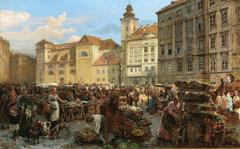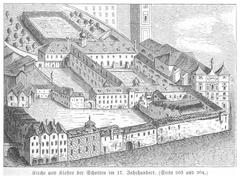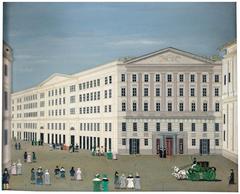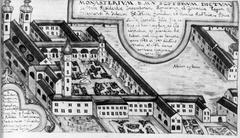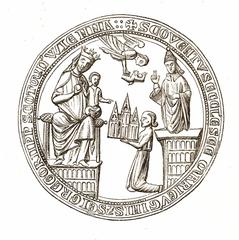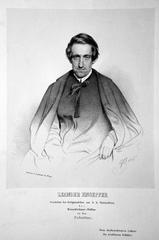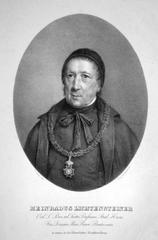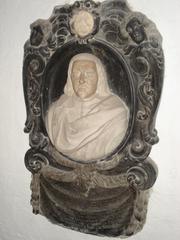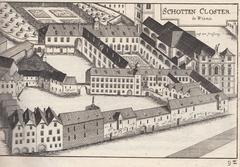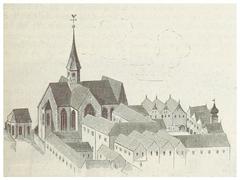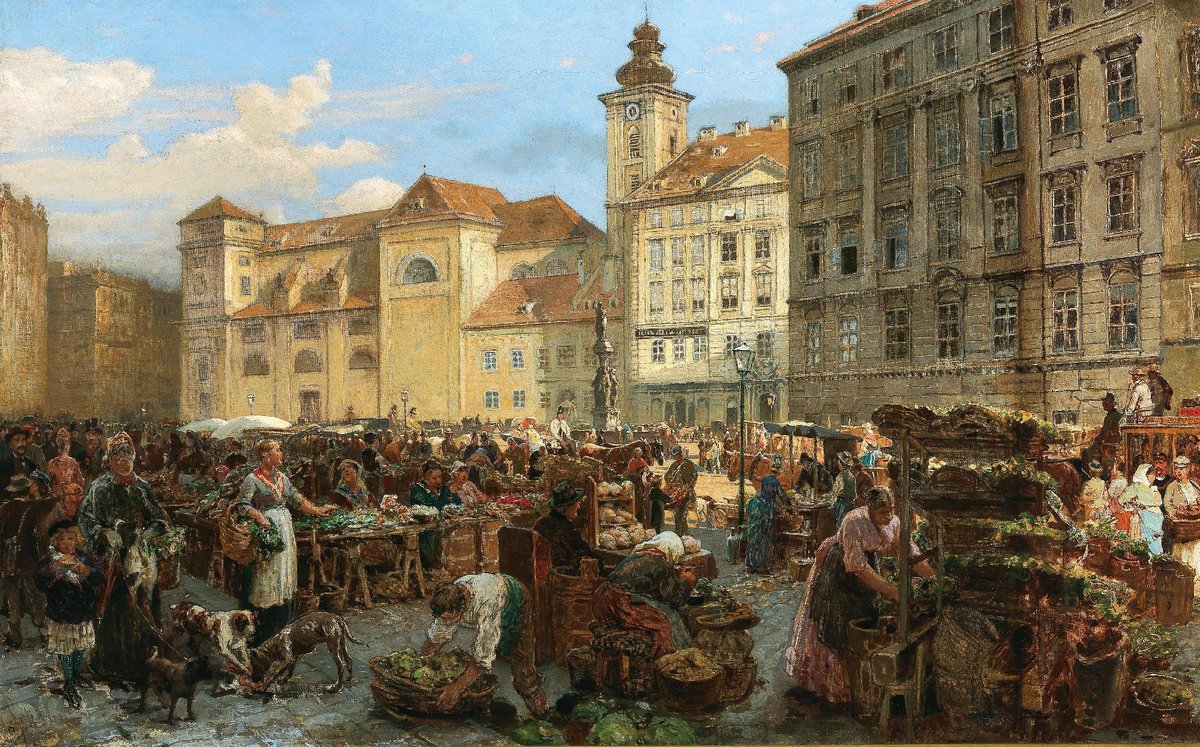
Schottenstift Vienna: Visiting Hours, Tickets, and In-Depth Historical Guide
Date: 14/06/2025
Introduction: The Legacy of Schottenstift
Situated on Vienna’s Freyung square, the Schottenstift—also known as the Scots Abbey—is one of the city’s oldest and most significant Benedictine monasteries. Founded in 1155 by Duke Henry II Jasomirgott for Irish Benedictine monks, the abbey has played a vital role in shaping Vienna’s religious, cultural, and educational landscape. From its Romanesque origins through Baroque transformation and 19th-century Classicist and Neo-Renaissance redesigns, the Schottenstift stands as a living monument to Vienna’s evolving identity.
This guide covers everything you need to plan your visit: up-to-date Schottenstift visiting hours, ticket details, accessibility, and highlights of its art, architecture, and ongoing cultural significance. Positioned near major landmarks like the Vienna State Opera and the Hofburg, Schottenstift offers a unique window into Austria’s layered past. For real-time updates and tours, refer to the official Schottenstift website and leading travel platforms (SpottingHistory, VisitingVienna, Wien.info).
Table of Contents
- Introduction
- Foundation and Early History (12th–13th Centuries)
- Reforms and Baroque Renewal (14th–17th Centuries)
- Enlightenment and Educational Flourishing (18th–19th Centuries)
- Architectural Evolution and Museum Highlights
- Practical Visitor Information: Hours, Tickets, Accessibility
- Schottenstift Today: Cultural Life and Events
- FAQs
- Conclusion
- References
Foundation and Early History (12th–13th Centuries)
Founded in 1155 by Henry II Jasomirgott, the Schottenstift began as a Benedictine monastery for Irish monks—“Scotia” being the medieval Latin name for Ireland (SpottingHistory). The monastery was strategically placed outside Vienna’s original city walls, providing hospitality to travelers and pilgrims. Construction commenced in 1160, and the Romanesque church, consecrated in 1200, became the Duke’s final resting place in 1177.
The abbey quickly emerged as a center of learning and spiritual life. A devastating fire in 1276 destroyed much of the original cloister, setting the stage for centuries of renewal and reconstruction (SpottingHistory).
Reforms and Baroque Renewal (14th–17th Centuries)
By the early 15th century, monastic reforms swept through Austria. In 1418, the Melker Reform replaced the original Irish monks with a new Benedictine community, though the “Schotten” name was retained (SpottingHistory). The abbey flourished as a hub for religious and intellectual revival.
Disaster struck in 1638 when lightning destroyed the church tower; the subsequent Baroque reconstruction, led by Andrea d’Allio the Younger and Silvestro Carlone, was completed in 1648. The church was adorned with new art, including an altarpiece by Joachim von Sandrart. Restoration followed the 1683 Turkish siege, with the modest Baroque west tower remaining a distinctive feature (VisitingVienna).
Enlightenment and Educational Flourishing (18th–19th Centuries)
The 18th and 19th centuries were marked by the abbey’s growth as an educational and cultural institution. Architect Andreas Zach constructed a new priory and school in the 1770s, reflecting the abbey’s educational mission (SpottingHistory). The Schottengymnasium, established by imperial decree in 1807, solidified the abbey’s intellectual prestige.
Architect Josef Kornhäusel redesigned the Freyung-facing buildings in Classicist style (1826–1832), while Heinrich Ferstel’s 1880 renovation introduced Neo-Renaissance elements, including a central altar mosaic by Michael Rieser and ceiling frescoes by Julius Schmid (Eichinger, TourMyCountry).
Architectural Evolution and Museum Highlights
Romanesque Remnants: The day chapel preserves Romanesque features, including the statue of Our Lady of the Scots (c. 1250) (Eichinger).
Baroque and Neo-Renaissance: The church’s Baroque interior features elaborate stucco and soaring columns, complemented by Neo-Renaissance ceiling frescoes by Julius Schmid and Ferstel’s altar mosaic.
Classicist Library: Kornhäusel’s library (1830) stands out for its refined woodwork and serene space. Guided tours grant access to the crypt, home to the tombs of Henry II Jasomirgott and his wife Theodora.
Museum Collection: The Schottenstift Museum houses the Schottenmeisteraltar (c. 1470), Vienna’s oldest topographical city depiction, as well as works by Rubens, Maulbertsch, and treasures ranging from liturgical objects to illuminated manuscripts (Wien.info).
Courtyard Sculptures: The Black Madonna (Schwarze Muttergottes, 1825) by Peter Nobile and the Jasomirgott Fountain (1651) are highlights of the abbey’s exterior (Wikipedia, TourMyCountry).
Practical Visitor Information: Hours, Tickets, Accessibility
Opening Hours
- Church: Daily, 9:00 AM – 6:00 PM
- Museum:
- Thursday & Friday, 11:00 AM – 5:00 PM
- Saturday, 11:00 AM – 4:30 PM
- Guided tours: Saturdays at 2:30 PM (VisitingVienna)
Tickets
- Church entry: Free
- Museum: €8 (adults); discounts for students, seniors, and Vienna City Card holders
- Tickets are available at the monastery shop near the main entrance and online.
Accessibility
- Main church and museum: Wheelchair accessible; some historic sections may have limited access.
- Accessible restrooms near entrance; contact staff for assistance.
Getting There
- U-Bahn: Schottentor (U2) and Herrengasse (U3) stations
- Trams: Lines 1, 71, D, 43/44
- Walking: 10 minutes from city center
Photography
- Permitted in most areas (no flash/tripods); restrictions may apply during services or special exhibits.
Visitor Amenities
- Gift shop, café, free Wi-Fi, and accessible facilities on-site.
Schottenstift Today: Culture, Worship, and Events
Schottenstift is an active Benedictine monastery, hosting daily Mass and the Liturgy of the Hours (open to visitors). The abbey is renowned for concerts, particularly during Vienna’s festival seasons, and for its educational workshops on topics like manuscript art and monastic brewing. Regular events include art exhibitions, lectures, and the annual Schottenfest. The surrounding Freyung square is lively with weekly organic markets and seasonal events (VisitingVienna).
The abbey continues its tradition of social outreach, supporting local communities and maintaining a leading role in education through the Schottengymnasium (TourMyCountry).
Frequently Asked Questions (FAQ)
Q: What are the current Schottenstift visiting hours?
A: Church: daily 9:00–18:00; Museum: Thursday & Friday 11:00–17:00, Saturday 11:00–16:30.
Q: How much are tickets?
A: Church entry is free. Museum tickets are €8 for adults, with concessions for students and Vienna City Card holders.
Q: Are guided tours available?
A: Yes, in German and English, mainly on Saturdays at 2:30 PM. Advance booking is recommended.
Q: Is Schottenstift wheelchair accessible?
A: Yes, most main areas are accessible; contact staff for details on historic sections.
Q: Can I attend religious services?
A: Yes, visitors are welcome at daily Mass and Liturgy of the Hours.
Q: What are nearby attractions?
A: Hofburg Palace, Stephansdom, Burgtheater, Volksgarten, and MuseumsQuartier.
Conclusion: Experience Vienna’s Spiritual and Artistic Heritage
Schottenstift is more than a relic of the past—it is a vibrant part of Vienna’s cultural and spiritual life. Visitors can explore a stunning fusion of architectural styles, world-class art, and ongoing monastic traditions. Its central location, accessible entry, and rich program of tours and events make it an essential destination for anyone seeking to understand Vienna’s heritage.
Plan your visit by checking the latest hours and ticket information on the official Schottenstift website. Download the Audiala app and follow our social channels for insider tips, audio guides, and updates on Vienna’s top historical sites.
Images (suggested for article enhancement)
- Exterior view of Schottenstift’s classicist façade and Baroque church
- Interior with Schottenmeisteraltar and ceiling frescoes
- Classicist library with woodwork
- Black Madonna statue in the courtyard
- Jasomirgott Fountain outside the church
References
- SpottingHistory: Schottenstift
- Eichinger Family Travel: Schottenstift
- Vienna Tourist Board: Schottenstift
- Tourist Info Vienna: Schottenstift
- VisitingVienna: Schottenkirche
- VisitingVienna: Schottenstift Museum
